How to Create a 4 Axis Wrapping Feature
Introduction
To create 4-axis wrapping features, you use the Wrapping Group in the CAM Tree. In this tutorial you use the Wrapping Group to add a milling feature that cuts text around a cylindrical part. The part is a 6-inch cylinder that is created by the stock (no part model is used). The feature geometry for this example is text. This tutorial provides a complete start-to-finish example of creating a Milling Job, stock, machine setup, CAM feature, program simulation, and finally posting the program to output the NC program (G-code).
Example File
The SolidWorks part file for this tutorial is available for download at: http://www.bobcad.com/helpfiles. If you are connected to the Internet, you can click the link provided to download and save the 4 AxisWrapping Example 1.SLDPRT zip file. After extracting the zip file, you can then open the example file to follow along with this example. The example file only contains the geometry for the example, so you create the job, stock, and define the machine setup before creating the feature to cut the feature.
The sketch geometry for this example is shown next. The rectangle represents the boundary of the cylindrical stock if it were unwrapped.
Tip: The Width (Y) value is the circumference of the cylinder. This was found by using the formula:C = PI * diameter.

Part 1) Create a Milling Job
-
In the Property Manager, click the
 CAM Tree tab.
CAM Tree tab. -
Right-click
 CAM
Defaults, and click NewJob.
CAM
Defaults, and click NewJob. -
In the Machining Job dialog box, select Milling.
-
Click to select the
 Start Stock Wizard check box.
Start Stock Wizard check box. -
In the Machine group, click the arrow, and select BC_4x_Mill.
-
To start the job by defining the stock geometry, click
 (OK).
(OK).
Part 2) Create the Stock
-
In the Stock Specification, click
 Cylindrical.
Cylindrical. -
In the Stock Orientation group, click the Extrusion Direction arrow, and select X Axis.
-
In the Size group, click Enter. Type the following values:
-
 Diameter = 4.0
Diameter = 4.0 -
 Height =
6.0
Height =
6.0 -
In the Stock Orientation group, click Enter Origin and type the following values:
-
X = 8.0
-
Y = 4.0
-
Z = -2.0
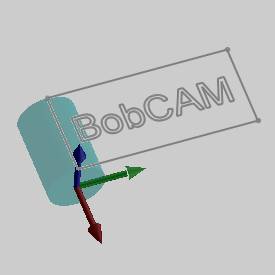
-
Click
 Next
to go to the Machine Setup.
Next
to go to the Machine Setup.
Notice the bounding entities that are automatically created to aid in selected the machining origin for the part.
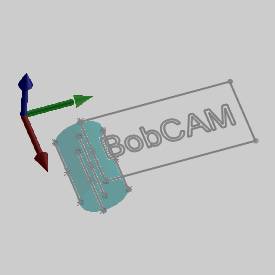
Part 3) Define the Machine Setup
-
In the Machine Setup tab, in the Origin group, select Pick Origin, and click in the PickOrigin box.
-
In the graphics area, click the end point of the line on top of the stock as shown next.
This defines the machining origin location on the stock.
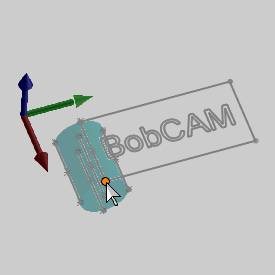
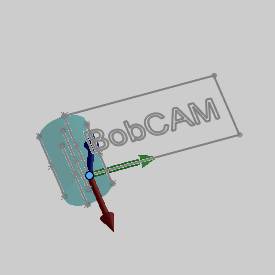
-
In the Work Offset group, type the following values:
-
X = 0.0
-
Y = 0.0
-
Z = 2.0
This setting defines the distance from the
machine zero to the machining (part) origin. In this example, because
the machining origin is not the same as the machine zero, the difference
is reported in the Work Offset. This is required to create proper NC programs
and simulation. (If the machining origin is placed at the center of rotation,
then the work offset values are all 0.00.)
-
In the Other group, set the Clearance Plane to 0.625.
-
The Machine Setup is now defined. To finish the Machine Setup, click
 (OK).
(OK).
Part 4) Add the Wrapping Group to the Machine Setup
-
In the
 CAM Tree, right-click
CAM Tree, right-click
 Machine Setup,
point to Additional Functions,
and click Add Wrapping Group.
Machine Setup,
point to Additional Functions,
and click Add Wrapping Group. -
In the CAM Tree, right-click
 Wrapping
Group, and click Edit.
Wrapping
Group, and click Edit.
The Wrapping Group dialog box displays. -
In the Wrapping Diameter box, type 4.000.
-
Under Wrapping Axis in the Origin group, set the values to X0 Y0 Z-2.
This defines the distance from the machining origin (set at the top of the part) to the center of rotation. -
Make sure that the Axis Direction is set to X Axis.
The defines the direction of the rotary axis as parallel to the X-axis. -
In the Zero Degree Location group, for Y = type 0.000.
This sets the distance, along the Y-axis, from the machining origin to the zero degree location of the part.
To learn more about the zero degree location, view the breakdown at the end of this tutorial. -
To accept the settings and close the dialog box, click
 (OK).
(OK).
Part 5) Add a Milling Feature to the Wrapping Group and Select Geometry
-
In the CAM Tree, right-click
 Wrapping
Group, and click Mill 2 Axis.
Wrapping
Group, and click Mill 2 Axis.
The 2 Axis Wizard displays. -
In the Geometry Selection dialog box, click Select Geometry.
-
In the graphics area, select the text.
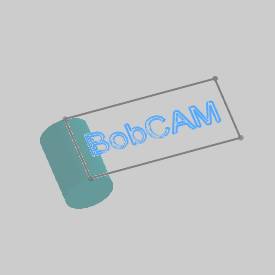
To accept the selection, click (OK).
(OK).
Click Next>>. -
In the Feature page, the Clearance Plane is automatically set using the value from the Machine Setup.
The default Rapid Plane (0.200) and Feed Plane (0.100) are both used for this example. -
Confirm that the Top of Feature is set to 0.000.
In the Total Depth box, type 0.1250.
The settings defined in the Feature dialog box are used for all operations in the feature.
Click Next>> to go to the Machining Strategy.
Part 6) Define the Machining Strategy and Posting Parameters
-
In the Template group, select the Pocketing template.
-
In the Current Operations group, select Profile Finish, and click
 (Delete Operation).
(Delete Operation).
The Current Operations group should now contain only one Pocket operation.
The Machining Strategy for the feature is now defined.
Click Next>> to go to the Posting dialog box. -
The Work Offset # is automatically set using the offset selected in the Machine Setup.
-
Notice that the Output Rotary Angle check box is cleared. This parameter is used to create manual indexing programs, and it is not needed for this example.
-
In the Contour Ramping Output group, you can select Line Moves or Arc Moves to define the output that your machine supports.
-
Click Next>> to go to the Multiaxis Posting dialog box.
Notice, at the top of the dialog box, that the Use Machine Settings check box is selected.
This means that the Multiaxis Posting parameters for the feature use the same parameters as the machine that is selected in Current Settings.
You can clear the Use Machine Settings check box to define the Multiaxis Posting parameters of the feature separately from the current machine settings. -
For this example, no changes are needed.
Click Next>> to go to the Tool page.
Part 7) Define the Tool Parameters
-
In the Diameter box, type 0.125 and press Tab.
-
In the Corner Radius box, type 0.000 and press Tab.
-
Using System Tool automatically updates the tool with tool parameters found in the Tool Library.
Notice that the holder is automatically assigned using the default holder stored with the tool. -
Click Next>> to go to the Patterns page.
Part 8) Define the Operation Parameters
-
In the Patterns group, confirm that Offset Pocket Out is selected.
-
For this example the Cut Direction is set to Climb Mill.
-
The Stepover % is set to 50.00.
-
Click Next>> to go to the Parameters page.
Part 9) Define the Remaining Parameters and Compute the Toolpath
-
For this example, set the Side Allowance to 0.000.
-
The Depth is set to Single Step for the Total Depth of 0.125.
-
Click Next>> to go to the Leads page.
-
In the Material Entry group, select Plunge.
-
Click Next>> to go to the Machine Sequence page.
The Machine Sequence is used to optimize the order of machining when selecting more than one chain for the feature. For this example there are two options that can be used to produce the same result: Closest and X Direction.
In the Sort Order group, select Closest.
For this example, each letter is a separate pocket. The Closest parameter causes the feature to cut one pocket and then cut the next adjacent (closest) pocket instead of jumping back and forth between letters. This is done to create the most efficient cycle time for the feature. -
To create the toolpath, at the bottom of the dialog box, click Compute.

Part 10) Simulate the Part
-
To simulate the part, right-click
 Milling
Job and click Simulation.
Milling
Job and click Simulation. -
The part displays in the simulation window. For help with simulation, view Getting Started with Simulation.

Part 11) Post the NC Program
-
In the CAM Tree, right-click
 Milling
Job, and click Post.
Milling
Job, and click Post.
The NC program displays in the Posting Manager tab.
Breakdown) About the Zero Degree Location
This section further examines the Zero Degree Location parameter of the Wrapping Group. This parameter is used to define what part of the toolpath is cut at the zero degree location of the cylinder. The Zero Degree Location parameter is the distance along the axis that is perpendicular to the rotation axis of the part. This distance, measured from the machining origin, defines what part of the feature is cut at the zero degree location of the cylinder. (This value can be positive or negative depending on how you set up the part and machining origin.)
The following explanation is given using the part geometry as it is drawn (in a flat plane). Once you understand how the parameter is applied in a flat plane, it is easier to understand how to apply the zero degree location as a distance around the cylinder.
-
The zero degree location of the cylindrical part is shown next, marked by a cone at the end of the cylinder.
The second image shows the location of the machining origin on the part (that was aligned with the zero degree location of the part).
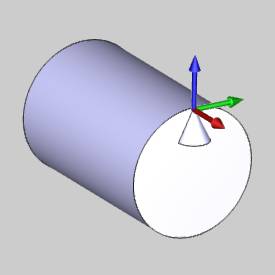
-
When you simulate the feature as created in this example, you can see the zero degree location of the part does not contain any of the text.
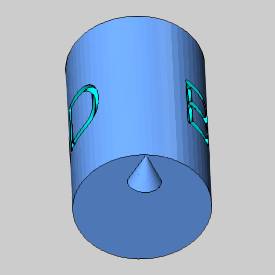
-
The following image shows a dimension that is added to measure the distance between the machining origin and the start of the letter C in the BobCAM text.
(Notice that this distance is measured perpendicular to the rotational axis of the part.)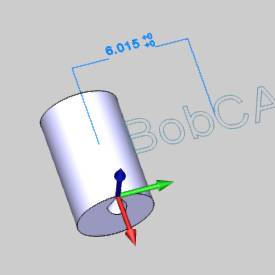
-
The next step is to set the Zero Degree Location parameter, in the Wrapping Group dialog box, to the distance between the machining origin and the beginning of the letter C. (Right-click Wrapping Group, and click Edit.)
The measured distance is used to set the Zero Degree Location parameter.
When you compute the toolpath and simulate the part, the start of the letter C is now aligned with the zero degree location of the cylinder as shown in the next image.

This example shows that you can use the Zero Degree Location to change the location of the machining feature on the part.
This concludes the tutorial.
